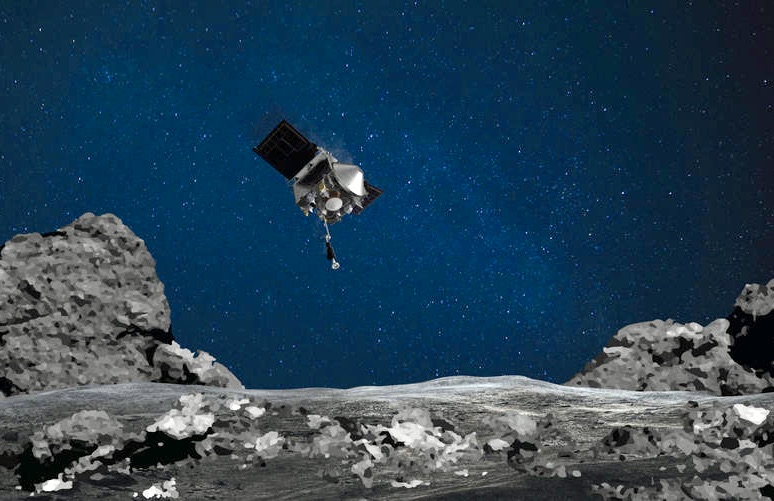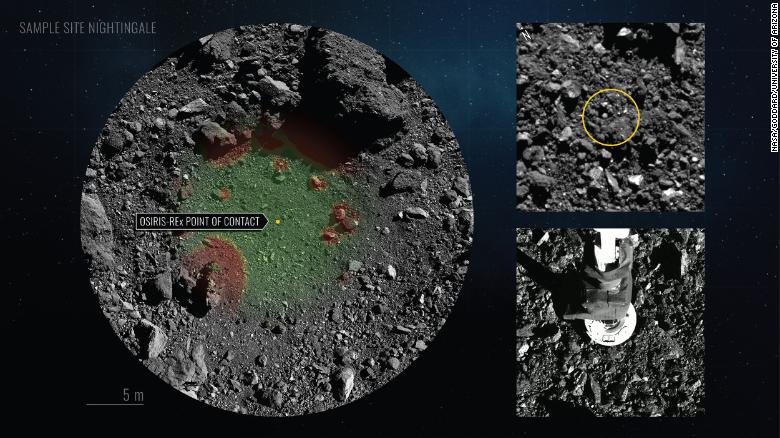Over 200 million miles away, NASA’s OSIRIS-REx spacecraft on Tuesday unfurled its robotic arm and descended to the surface of the asteroid Bennu. It appeared to crush some rock as it touched down, quickly fired some nitrogen gas to kick up the sample and then after 5 or 6 seconds it flew away to safety after a back-away burn.
One day after the “tag,” NASA officials announced that the sample collection appeared to have been it to be a successful, and they released images and video of the dramatic scoop. The spacecraft touched down within three feet of the Nightingale target location and NASA officials said that most of the sample collection occurred in the first three seconds.
The sample will consist of grains of a surface that has experienced none of the ever-active geology on Earth, no modifications caused by life, and little of the erosion and weathering. In other words, it will be a sample of the very early solar system from which our planet arose.
The asteroid visit is the first ever accomplished by NASA, following in the path set by the Japan Aerospace Exploration Agency (JAXA) and its two Hayabusa missions.
“This amazing first for NASA demonstrates how an incredible team from across the country came together and persevered through incredible challenges to expand the boundaries of knowledge,” said NASA Administrator Jim Bridenstine. “Our industry, academic, and international partners have made it possible to hold a piece of the most ancient solar system in our hands.”

While it remains somewhat unclear how much sample was collected by OSIRIS-REx, the mission’s principal investigator, Dante Lauretta of the University of Arizona, said he was optimistic.
The sampling mechanism touched down in part on a rock about 8 inches wide, something that could have prevented the gathering mechanism from pressing up properly against the surface.
“I must have watched about a hundred times last night,” Lauretta, said during a news conference on Wednesday. “But literally, we crushed it. When the spacecraft made contact, that rock appears to fragment and shatter, which is great news.”
“Bottom line is from analysis of the images that we’ve gotten down so far, is that the sampling event went really well, as good as we could have imagined it would,” he said. “And I think the chances that there’s material inside… have gone way up way up based on the analysis of the images.”

The amount sample required for mission success is about 60 grams — about a full-size candy bar — but the capsule can hold up to 2 kilograms of material from the asteroid’s surface.
The team will now work to determine the amount of sample collected. One method involves taking pictures of the head of the robot arm with a camera known as SamCam, which is devoted to documenting the sample-collection process and determining whether dust and rocks made it into the collector head.
Another indirect indication will be the amount of dust found around the sample collector head. OSIRIS-REx engineers also will attempt to snap photos that could, given the right lighting conditions, show the inside of the head so engineers can look for evidence of sample inside of it.
If the sample is successfully collected, the spacecraft will head back to Earth early next year and is scheduled to arrive September 2023, when it will parachute the sample container onto Utah’s west desert and awaiting scientists. JAXA’s Hayabusa2 sample is scheduled to be dropped on the desert of western Australia later this year.
A Many Worlds column about the science of OSIRIS-REx (an acronym for the Origins, Spectral Interpretation, Resource Identification, Security-Regolith Explorer) and the asteroid Bennu can be accessed here.
